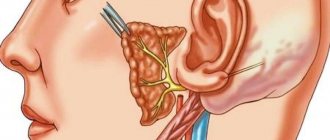Polyneuritis - damage to the structure of multiple nerve fibers can develop at any age. In rare cases, the disease occurs and develops as an independent illness, but most often it is a secondary complication of toxic poisoning, trauma, diabetes, and alcohol addiction. The first possible signs of polyneuritis are considered to be the appearance of a feeling of numbness and “running” goosebumps in the extremities, recorded over several weeks; later, a decrease in physiological muscle tone and insufficiency of tendon reflexes are noted.
Types and features of polyneuritis
The disease is characterized by predominant pathological damage to the distal, that is, distant parts of the nervous system of the extremities, this is manifested by a decrease in sensitivity and strength in the hands and feet, while in the higher located parts these signs characteristic of the disease appear already in advanced cases.
Treatment of the disease depends on the influence of the primary cause, so during diagnosis it is necessary to identify this provoking factor.
Polyneuritis, first of all, covers the nerve sections of the limbs, therefore the symptoms of the disease are associated precisely with this area of the human body. Polyneuritis of the extremities usually begins with a feeling of decreased temperature in the feet and hands, and later a loss of sensitivity occurs.
The pathological reactions that occur in the nerves are characterized by the presence of dystrophic changes; their inflammation is not typical in this disease.
The course of polyneuritis and its prognosis depend on the cause of the disease, so the attending physician must determine the etiology of the disease before treatment.
Alcoholic polyneuritis
It is characterized by the simultaneous appearance of severe sensory and motor disorders. For this type of disease, the characteristic defining symptom is the presence of mental disorders, the most obvious of which is pathological memorization - the patient does not remember the events that occurred and may distort events and facts.
The patient fills in the gaps in memory with fiction, which sometimes has an obviously fantastic plot. To this is added polyneuritis of the lower extremities. The legs or arms become bluish, lose sensitivity and mobility.
Polyneuritis of the kidneys
Develops with severe glomerulonephritis and pyelonephritis. The disease is associated with impaired glomerular filtration. Swelling appears in the lower extremities, weakening of the arms and legs.
Acute polyneuritis
Usually develops during or after illnesses with a viral nature of origin. After eliminating the main cause, low-grade fever, “aches” in the limbs, and severe, burning pain along the nerves appear. All symptoms increase in a matter of hours or days.
Diabetic polyneuritis
Develops in patients with diabetes mellitus. In some cases, disturbances in the limbs that are noticeable to the patient are recorded earlier than the symptoms of the underlying disease.
With successful treatment of the underlying disease, the symptoms of polyneuritis can persist for a long time, manifested by difficulties in walking, the inability to perform precise manipulations with the fingers, muscle atrophy and paresis.
As already mentioned, the cause of polyneuritis can be various diseases. Thus, VSD against the background of cervical osteochondrosis can lead to the manifestation of symptoms of polyneuritis. You can read about this in this article.
Symptoms and manifestations of hydrocephalus or dropsy of the brain are quite extensive and varied. Read more about the disease.
Chronic polyneuritis
Gradually develops with constant exposure to the disease-provoking factor. Severe weakness and atrophy in the muscles located in the lower and upper extremities slowly increases, then signs of changes in the functions of the brain and spinal cord appear, speech disorders and inflammation of the meninges may be recorded.
Toxic polyneuritis
Develops under the influence of alcohol, salts of heavy metals. Depending on the amount of toxin entering the body, it can be acute or subacute.
Acute poisoning is accompanied by obvious symptoms of intoxication - vomiting, pain in the digestive tract, diarrhea.
Then the noticeable signs that define polyneuritis and the deterioration of the general condition are added.
Vegetative polyneuritis
Occurs in cases of intoxication, thyrotoxicosis, and negative professional working conditions. This form of the disease is characterized by the spread of burning pain throughout the body, deterioration of tissue trophism, expressed by changes in temperature, excessive or insufficient sweating.
Infectious polyneuritis
It is caused by an infectious agent and is considered a long-term consequence of the disease. It begins with fever, lesions in the extremities are usually recorded in two at once and develop along an ascending path, that is, from the feet to the higher nerve fibers.
Alimentary polyneuritis
It is caused by a lack of vitamin B in food or its improper absorption by the body. In addition to signs of pathological damage in the peripheral nerves of the extremities, serious disturbances in cardiac activity are recorded.
Content:
- Symptoms of the disease
- Reasons for development
- Why is alcoholic polyneuritis so dangerous?
- Alcoholic polyneuritis is a cause of mental disorders
- Features of treatment
- Is it possible to do something on my own?
Every tenth person suffering from alcoholism is diagnosed with alcoholic polyneuritis. With this disease, the sensitivity of the hands and feet decreases, and basic motor reflexes decrease.
The disease causes the intake of high doses of ethanol, as a result of the breakdown of which a high toxic load is placed on the body and nerves are damaged. With polyneuritis, the spinal and cranial nerve endings are affected, the activity of the spinal cord and brain is disrupted.
If symptoms of the disease occur, you should receive qualified medical care as soon as possible and undergo treatment prescribed by your doctor. It is unacceptable to ignore negative symptoms, as this can ultimately lead to disability.
Types
Polyneuritis of the lower extremities
- infectious type. Appears due to catarrh of the upper respiratory tract. A type such as infectious polyneuritis involves an increase in temperature, as well as inflammation of cells;
- diphtheria type. Appears when treatment is started incorrectly or untimely. The soft palate is paralyzed, the nasal tone in the voice increases. Eating as a result of vagus nerve disease is usually difficult;
- lead type. It often appears due to the consumption of sour berry jam, which was preserved in clay dishes. The disease affects the radial nerves. The patient complains of abdominal pain, as well as lead plaque in the gum area;
- arsenic type. There are two types: household and professional. Signs of the disease are stomach pain, vomiting and paralysis of the lower extremities;
- diabetic type. Suggests nerve damage to the face, arms, or legs;
- professional type. Occurs in people whose professional activities involve tools that emit vibration or work that involves strong muscle tension. Symptoms include pain in the hand, pale fingertips and sweating.
Symptoms of the disease and diagnosis
The disease can manifest itself in the following symptoms:
- soreness in the arms and legs, numbness;
- sensitivity is lost;
- muscle weakness occurs;
- sweating in the extremities increases;
- the color of the skin changes (pallor appears, it becomes thinner, swelling appears);
- motor functions are upset;
- there is a change in the structure of the nails.
The doctor makes a preliminary diagnosis during examination of the patient. To confirm this, a number of additional studies are carried out:
- general urine and blood tests (to detect toxins);
- examination of internal organs and thyroid gland;
- electroneuromyography method (determines the degree of passage of electrical impulses along the nerve endings and evaluates the condition of the muscles).
Differences between polyneuritis and neuritis
The main difference between polyneuritis and neuritis is the generalization of the entire pathological process. With neuritis, one nerve may suffer, which is manifested by the presence of pain at its location.
With polyneuritis, nerve damage is usually defined as symmetrical and affects several groups at once, which only aggravates the severity of the disease and the patient’s well-being, gait and performance are impaired.
The cause of local neuritis can be tumors, injuries or arthritis, while polyneuritis has an infectious and toxic etiology of origin.
Alcoholic polyneuropathy
Ethanol disrupts the integrity of neuron processes and their membranes, which is manifested by sweating of the hands, swelling of the hands and feet.
The disease progresses slowly and - which is typical - when you give up alcohol, the functions of the nerve fibers are resumed.
Alcoholic neuropathy is often associated with brain damage. If it turns into dementia, normalization of the activity of nerve cells when giving up alcohol is impossible.
The disease is treated with vitamin therapy, drugs that improve tissue respiration, and hepatoprotectors.
Reversibility distinguishes alcoholic polyneuropathy from all other types of disease, but not everyone is able to cope with the addiction.
One of the complications of diabetes is diabetic neuropathy of the lower extremities, which can lead to gangrene if treatment is not started in time.
The massage technique for neuritis of the facial nerve is described here.
An occupational disease for drillers and people who work on vibrating equipment is vibration disease. Symptoms, types and diagnosis are described in the article.
Classification of polyneuritis
Before starting treatment, it is necessary to identify not only the form (chronic or acute) of the disease, but also its type. Depending on the reasons that led to the spread of polyneuritis, different treatments are prescribed. Polyneuritis is divided into two broad categories - axonopathic (the nerve axon dies) and demyelinating (the nerve sheath is destroyed). Further classification indicates the source of the disease:
- Infectious polyneuritis
. Occurs during inflammatory processes in the peripheral nervous system. One of the most dangerous types of pathology, since it is characterized by a large affected area and the death of many nerve fibers.
- Diphtheria polyneuritis
. Occurs in 10-20% of children who have had diphtheria when the disease is not diagnosed and treated in a timely manner.
- Alcoholic polyneuritis
. The inflammatory process is accelerated due to excessive consumption of alcoholic toxic substances. The development of alcoholic polyneuritis is accelerated by the constant intake of toxins and poisonous substances.
- Arsenic polyneuritis
. Consequence of arsenic poisoning of the body. It does not have a chronic form, since the disease immediately becomes acute.
- Diabetic polyneuritis
. Peripheral nerves of the face or limbs are damaged.
The classification is not limited to the cause of the disease. As we mentioned earlier, there are acute and chronic forms of polyneuritis. The acute form is one of the most dangerous manifestations of polyneuritis; it develops in a matter of hours or days. Most often, the acute form of the disease occurs against a background of weakened immunity and a previous infectious disease. The chronic form of the disease progresses slowly and can be easily missed by both the patient and the attending physician. The disease is growing every day against the backdrop of constant exposure to provoking factors - alcohol, poisoning, infection.
Causes of polyneuritis
The reasons leading to the development of polyneuritis are conventionally divided into several groups:
- Infections - sore throat, diphtheria, influenza, various types of typhoid infection, severe dysentery.
- Exogenous intoxication factors - poisoning with alcohol substitutes, lead, chlorophos, arsenic.
- Endogenous intoxications developing with diabetes mellitus, thyroid pathologies, nephritis.
- Avitaminosis is a lack of B vitamins.
- Professional working conditions – constant work in the cold, vibration of tools.
- Chronic metabolic disorders.
In addition, the development of polyneuritis can be facilitated by the presence of a disease such as encephalopathy. They are inextricably linked and are characterized by loss of sensitivity and motor functions of the extremities, both upper and lower.
The signs of polyneuropathy of alcoholic origin are similar to the manifestations of polyneuritis. It is very important, when you first notice symptoms, to immediately seek qualified help.
The prognosis for the treatment of alcoholic encephalopathy in the later stages is most often unfavorable. You will find out why from the article.
How to cure a nervous tic of the eye in various ways is described in detail here https://gidmed.com/bolezni-nevrologii/nevralgija/nervnyj-tik-glaza-prichiny-vozniknoveniya-i-lechenie.html.
Causes and symptoms of polyneuritis (polyneuropathy)
There is a certain range of reasons that can cause polyneuropathy (polyneuropathy, polyradiculopathy) and polyneuritis (neuritis, radiculoneuritis, radiculitis, polyradiculoneuritis):
- Metabolic disorders . The tissue of the nervous system is very demanding in terms of providing it with nutrients. The slightest deficiency can lead to disruption of nerve function and even death of nerve fibers. Most often we find two types of polyneuropathy: diabetic polyneuropathy, polyneuropathy due to disease of the thyroid and other glands.
- Infectious inflammation in various neuroinfections . Most often, this is inflammation of the peripheral nerves with the herpes zoster virus (Herpes Zoster, Varicella Zoster), neuroborreliosis.
- Autoimmune inflammation of the nerves , i.e. aggression of the immune system towards the tissue of the nervous system. It occurs due to a genetic predisposition and is often triggered by infection and chronic stress. The immune system recognizes peripheral nerve tissue as foreign and attacks and destroys it. Typical cases of autoimmune polyneuropathy: CIDP demyelinating polyneuropathy, Guillain-Barré polyneuropathy, polyneuropathy in rheumatic diseases, viral hepatitis, polyneuropathy in sarcoidosis.
- Toxic damage to peripheral nerves. The tissue of the nervous system is sensitive to various toxins (poisons). These can be solvents, paints and varnishes, metals, household poisons, narcotic substances, etc. Most often we detect Alcoholic polyneuropathy.
Possible symptoms (polyneuritis, radiculopathy, polyradiculoneuritis, polyneuropathy and other diseases of this group):
- Numbness and decreased sensitivity, usually starting in the hands and/or feet (like “gloves” and “socks”), may spread upward;
- Increased sensitivity (tactile, temperature, etc.), starting, as a rule, in the hands and/or feet (like “gloves” and “socks”), may spread upward;
- Muscle weakness (paralysis, paresis), usually starting in the hands and/or feet, spreading upward;
- Impaired vision, hearing, and smell due to disruption of the conduction of excitation along the visual, auditory nerves and olfactory tract;
- Impaired balance and coordination, unsteadiness, dizziness due to a deficiency of signals entering the brain from sensory receptors;
- Pain along the nerves when they are inflamed; when affected by the herpes virus, the pain is accompanied by skin rashes along the nerves;
- Skin rashes are usually a sign of infection by the herpes virus (Varicella-Zoster), painful blisters surrounded by an area of redness of the skin, which eventually open and form crusts;
- Violation of pelvic functions, i.e. bladder and bowel dysfunction due to lack of nervous system control;
- General malaise, fatigue, fever, depression, apathy.
If motor nerve fibers are damaged (they transmit commands from the brain to the body), then the functioning of muscles and other executive organs (for example, the bladder and intestines) may be disrupted.
If sensitive nerve fibers are damaged (they transmit information from the sensitive receptors of the body to the brain), then a decrease or distortion of sensitivity (skin sensitivity, vision, hearing, smell, joint-muscular sense) is possible.
Prevention measures
Polyneuritis can develop in any person; the main measures to prevent it include the following:
- Elimination of the influence of toxic substances.
- Prevention of viral infections.
- Compliance with safety precautions when working with poisons.
- In special working conditions - compliance with all recommendations for performing work.
A balanced and rational diet and treatment of chronic diseases are important in preventing illness.
Polyneuritis is a serious and dangerous disease associated with damage to the peripheral nervous system. The pathology is multiple and extensive. Polyneuritis is accompanied by multiple paresis, decreased functionality and sensitivity of the limbs. With the acute nature of the disease, polyneuritis can become complicated. Inflammatory processes that have spread to the central nervous system significantly worsen the patient’s well-being.
Causes of the disease
Diagnosis of polyneuritis begins with identifying and identifying the causes of the disease. Most often, infectious polyneuritis is caused by external mechanical or toxic effects. When collecting anamnesis and determining the clinical picture, special attention should be paid to interactions with poisons - polyneuritis is often caused by poisoning the body with mercury or lead. However, this is not the main reason for the development of pathology - strong antibiotics, drug or alcohol abuse can also damage the peripheral nervous system and cause uncontrolled spread of the disease.
Also causing the spread of polyneuritis are severe bacterial or oncological diseases, in which the peripheral nervous system loses the ability to function normally. Mistaking its own nerve fibers for dangerous foreign bodies, the body can begin to attack itself - this is how the autoimmune nature of polyneuritis manifests itself.
Symptoms of the disease
Patients note the following symptoms:
- Periodic goosebumps, burning sensation and numbness.
- On examination, the skin of the extremities is pale, sometimes with a marbled pattern, colder to the touch than the rest of the body and moist due to excessive sweating.
- Weakness in the muscles begins to manifest itself as discomfort when performing usual work - patients cannot fasten buttons, it is difficult to hold small objects in their hands.
- On the feet, the muscles involved in dorsiflexion weaken, this leads to the fact that the leg seems to hang down and when walking a person is forced to raise the limb high.
- Sensitivity is impaired - many patients do not feel touch, changes in external temperature, or pricks with sharp objects. At the same time, burning and severe pain are expressed.
- Changes in deep-seated muscles lead to movement disorders, unsteady gait, and trembling of the hands.
- Over time, the skin on the extremities becomes thinner, becomes swollen and acquires a dark purple hue, and the structure of the nails changes.
In unfavorable cases, the fibers of the vagus nerve may be involved in the pathological process, which is manifested by a functional disorder of breathing and cardiovascular activity.
Severe pneumonia with severe shortness of breath and tachycardia is recorded. Without appropriate treatment, this condition can be fatal.
The photo shows damage to the lower extremities with polyneuritis:
Symptoms of the disease
At the very beginning of the development of pathology, nothing worries the alcohol addict. Only occasionally does he notice an unpleasant feeling of crawling “goosebumps”, which intensifies after a long stay in an uncomfortable position or after sleep. The usual sensitivity is restored in about an hour. And for this you do not have to take any special measures.
Gradually, the “goosebumps” are accompanied by decreased muscle tone. Then the basic neurological reflexes fade away. Massage helps the drinker compensate for the unpleasant sensations.
If you do not start treatment for alcoholic polyneuritis of the lower extremities at the stage of muscle weakness, atrophy of the calf muscles will occur. The skin will turn blue and begin to peel very much. A bluish tint to the skin indicates the progression of cyanosis - this is a dangerous condition in which the concentration of carboxyhemoglobin in the blood increases.
Other symptoms of the disorder include:
- brittleness and layering of nails;
- the appearance of bald spots in the calf muscles;
- increased sweating;
- the formation of painful trophic ulcers that heal extremely slowly;
- sweating of the feet;
- constantly cold feet;
- severe pain in the legs.
Two to three months after the appearance of the listed symptoms, alcoholic polyneuritis of the lower extremities spreads to the hands. Then a huge number of nerves are involved in the pathological process. It becomes difficult for an alcohol addict to control his own body. He constantly feels severe muscle weakness.
When examining the patient, the specialist will note the minimization of motor reflexes, the “cock” gait characteristic of the disease (as they say if a person lifts one leg very strongly while walking due to impaired functioning of the extensor muscles of the foot).
Preventive measures
To reduce the likelihood of developing kidney polyneuritis, doctors recommend:
- completely give up bad habits (tobacco, alcohol), follow the principles of a healthy lifestyle;
- eat well and properly, avoid eating too salty, pickled, smoked and too fatty foods;
- avoid hypothermia, protect the lower back (at low temperatures, wear high-waisted trousers, a jacket below the knees, a special woolen belt, etc.);
- promptly diagnose and treat kidney infections and urinary tract infections;
- strengthen the immune system;
- observe safety precautions at work.
Have you had your kidneys checked lately?
Since renal polyneuritis is most often a consequence of pyelonephritis or glomerulonephritis, it is important to be attentive to your health and undergo regular preventive examinations. Timely diagnosis and treatment of acute kidney infections in most cases leads to complete recovery of the patient without the disease progressing to the chronic stage. This significantly reduces the risk of developing polyneuritis and other serious complications.
Diagnostics
Making a diagnosis is usually not difficult. The doctor examines and interviews the patient.
Among additional research methods, the following are important:
- Determination of the presence of toxic substances in biological fluids - urine, blood.
- Examination of internal organs and endocrine system.
- Exclusion of oncological pathologies.
- Electromyography is a study aimed at studying the electrical impulses of muscle fibers. This examination is recommended to be performed during the treatment period as a control over the improvement of the disease.
Diagnosis of polyneuritis
A specialized doctor can determine the presence or absence of such a serious disease in the early stages of the development of polyneuritis. An experienced neurologist can easily determine not only the presence or absence of the disease, but also its nature and classification. To achieve this, a number of clinical tests and medical studies are carried out:
- Collecting anamnesis and interviewing the patient. Often at this stage, the neurologist already has a clear idea of the patient’s illness – characteristic complaints and visible signs allow one to determine the presence or absence of the disease.
- To confirm the results of the initial survey and examination, biochemical blood and urine tests are performed. A laboratory technician will test the fluids for toxic substances.
- The final stage of collecting information is the diagnosis of the endocrine and pancreas, liver and kidneys.
- In order to determine the extent of damage to the peripheral nervous system and determine the stage of polyneuritis, electromyography is used - a tool for determining the electrical conductivity of muscles.
An oncologist also takes part in the diagnosis. With its help, a neurologist can differentiate polyneuritis and not confuse it with cancer.
Treatment
All forms and types of polyneuritis begin to be treated according to the same scheme:
- In the acute period, bed rest and rest are prescribed.
- It is necessary to eliminate the influence of intoxication; in case of acute poisoning detected by laboratory diagnostics, antidotes are administered, that is, drugs aimed at neutralizing toxins.
- For infectious polyneuritis, 4% Urotropin or 1% Tripaflavin is administered for several days. For the diphtheria form, the administration of anti-diphtheria serum is indicated; for the influenza form, interferons and gamma globulins are indicated.
- Detection of vitamin deficiencies requires a course of vitamin complexes, especially from group B.
- To reduce swelling on nerve fibers, Magnesium sulfate, Glucose, and diuretics are prescribed.
- Improve microcirculation and metabolism by using Aminalon, Nootropil, Trental, and potassium supplements.
- Analgesic therapy is selected based on the severity of the pain symptom and the presence of concomitant diseases.
After the acute period, physiotherapy, massage, mud therapy, therapeutic exercises, and reflexology are indicated. To prevent the development of contractures in cases of severe atrophy and weakness in the limbs, splints are put on them.
The recovery period lasts several months, during which time sanatorium-resort treatment, constant massage and gymnastics, and a specially formulated diet have a good effect.
The diet should be especially rich in B vitamins - pork, buckwheat and oatmeal, eggs, dairy products, liver, kidneys, brewer's yeast.
It is recommended to constantly drink freshly prepared vegetable and fruit juices, especially carrots. During the recovery period, radon and hydrogen sulfide communal baths are used.
Unconventional methods of treatment
Traditional methods of treatment can be considered only after the acute signs of the disease have been eliminated. The patient is recommended to drink herbal decoctions that improve metabolic processes in the body and use compresses.
- Crushed stems and leaves of garden raspberries in the amount of a tablespoon are poured into a glass of boiling water and left for a little less than an hour. Take three tablespoons before meals.
- A spoonful of Ivan tea herb is poured with half a liter of boiling water, placed in a thermos and left for 8 hours. Drink the infusion throughout the day.
- Nettle and birch leaves improve metabolic processes. They can be brewed separately or together at the rate of one spoon of the mixture per half liter of boiling water. The prepared decoction is drunk a day before.
To prepare compresses or baths, take plants such as wormwood, birch and eucalyptus branches, and pine shoots. To prepare a bath, 100 grams of the plant and a liter of boiling water are enough, the resulting infusion is poured into water.
Traditional methods of treatment
Unconventional methods are used when the disease does not have acute manifestations. Polyneuritis is treated with herbal preparations, decoctions, and compresses.
In order to get rid of the disease, take already chopped raspberry stems and leaves (1 tablespoon) and pour boiling water (1 glass), leave for one hour, consume 3 tablespoons before meals.
For the same purpose, the herb Ivan tea is brewed (1 spoon per 1.5 liters of boiling water, the decoction is infused for 8 hours, drunk during the day). An infusion of nettle and birch is made in the same proportions.
For sciatic nerve disease, it is recommended to apply chamomile and elderberry (flowers) to the sore spot; horseradish compresses can also bring relief.
A mixture of red clay and vodka is applied to problem areas, and rubbing the bear with lard is also practiced.
They also use the following remedy: pour a glass of boiling water over a lingonberry bush and keep it in a water bath for an hour and a half. You need to take the medicine one tablespoon several times a day (3-4).
Folk remedies
“Grandma’s” recipes can be used as an independent preventive measure and as an addition to therapy prescribed by a doctor. For urological diseases, brew lingonberries, cranberries, chamomile, raspberries, fireweed, and make warm compresses from red clay and vinegar or from a decoction of elderberry and chamomile flowers. Lotions made from poppy pods have an analgesic effect.
Traditional medicine offers the following recipes:
- half a tablespoon of dried birch leaves and the same amount of dried nettle leaves, pour 0.5 liters of boiling water, leave for 1 hour, drink everything on the same day;
- 1 tbsp. Pour 0.5 liters of hot water over fireweed tea and leave overnight. Drink 1/3 of the decoction per day in 3 servings;
- 1 tbsp. Infuse dried raspberry stems and leaves in a glass of boiling water for 40 minutes. Take 3 tablespoons before meals;
- Brew 100 g of a mixture of pine stems and wormwood, birch and eucalyptus leaves with 1 liter of boiling water. Pour the resulting infusion into a bath, which should be taken at night for 15 minutes.
Folk remedies must be approved by a doctor. Otherwise, the situation may get worse. For example, consuming a decoction of rose hips, lingonberry or cranberry juice is fraught with the deposition of salt crystals.
Alcoholic encephalopathy is damage to brain cells caused by long-term alcohol addiction. The disease causes serious consequences that can greatly aggravate the health condition.
As a result of excessive alcohol consumption, another dangerous disease develops - alcoholic polyneuropathy. Read about the symptoms and treatment of this disease here.
You can read how diabetic polyneuropathy is treated in this material.
Consequences and prognosis
Timely treatment of polyneuritis usually results in a favorable outcome; it must be taken into account that the restoration of nerve fibers takes months.
Therefore, during the recovery period, it is necessary to fully comply with all the doctor’s recommendations, undergo physical therapy and pay attention to nutrition.
It is also necessary to exclude contact with substances that cause intoxication - repeated exposure to them leads to relapses, the treatment of which will be difficult and long.
If parts of the vagus nerve are involved in the process and if help is not provided in time for this condition, the outcome of the disease can be fatal.
Frequent and prolonged headaches in the temple area should not go unnoticed. Any pain must be correctly diagnosed and treated in order to avoid serious consequences in the future.
Everything about the symptoms and treatment of occipital neuralgia is described in detail in the article.
Pathological anatomy
Rice. 1. Microscopic specimen of the vagus nerve in polyneuritis: arrows indicate accumulations of macrophages in foci of segmental demyelination; hematoxylin-eosin staining; x 100. Fig. 2. Microslide of the optic nerve for polyneuritis: infiltrate in the focus of demyelination, containing lymphocytes (1) and macrophages (2); hematoxylin-eosin staining; X 400. Fig. 3. Microscopic specimen of nerve fibers of the anterior root of the spinal nerve in acute polyradiculoneuritis: 1 - clear and band-like swelling, 2 - lysis of the nerve fiber, 3 - proliferation of lemmocytes; silver impregnation; X 1500. In pathomorphology. P. is divided into parenchymal and interstitial. Among parenchymal P., there are forms with predominant changes in myelin and lemmocytes (periaxonal P.) and forms with a predominance of axon damage (axonal P.). Interstitial P. are characterized by changes in the membranes and vessels of peripheral nerves. Forms involving the roots and spinal ganglia are called polyradiculoneuritis. Depending on the etiology of the pathomorphology process, the picture has a number of differences. In acute primary P. of infectious-allergic origin, clinically occurring as Landry's ascending paralysis (see Landry ascending paralysis) or Guillain-Barre-Strol syndrome, a predominant lesion of the myelin sheaths is observed. In the early stages of these diseases, there is an accumulation of mononuclear cells near the myelin sheaths, which undergo decay. At the same time, lemmocytes proliferate, and their number increases 8-14 times. The myelin sheaths swell, acquire a honeycomb-like structure, myelin balls form and, in some places, myelin dissolves. In foci of demyelination, especially those located perivenously, focal necrosis is formed (Fig. 1) with an accumulation of macrophages containing fat. Inflammatory perivenous and pericapillary infiltrates consist of lymphoid cells, polymorphic mononuclear cells, and macrophages (Fig. 2). The axon increases in size, its ribbon-like swelling occurs, clear-shaped swellings are formed along the axon, lysis of fibers and proliferation of lemmocytes occur (Fig. 3). The death of nerve fibers leads to the development of Wallerian degeneration (see Wallerian degeneration). Due to the destruction of myelin, the endoneural spaces are brought closer together, and the perineural spaces are expanded and infiltrated with lymphoid elements. The inflammatory and demyelinating process in primary P. is reversible. Remyelination occurs in the 2-3rd week. from the onset of the disease, as a rule, is accompanied by regeneration of nerve fibers. In rare cases, axons die and collagen fibrils and amorphous endoneurium substance form in their place.
Rice. 4. Microscopic specimen of a nerve fiber in porphyrin polyneuritis: 1 — decay of nerve fibers, 2 — endoneurium fibers, 3 — macrophages, 4 — bundles of slightly changed nerve fibers; Van Gieson staining; X 460.
With hypovitaminosis, diabetic, toxic, porphyrin, alcoholic P., predominantly axonal damage is observed, which is accompanied by axonal degeneration, proliferation of lemmocytes, swelling of motor motor terminal plaques. In nerve fibers, various stages of axonal death can be traced, up to their complete disappearance. In place of the dead nerve fibers, randomly located endoneurium fibers and macrophages remain (Fig. 4). Simultaneously with axon degeneration, regeneration processes can be traced, when new small fibers are formed in place of dead fibers. In the later stages of regeneration in myelinated nerve fibers, individual axons reach normal size, most of them remain atrophic. Axonal neuropathy is accompanied by myelin degeneration, most often in the form of segmental demyelination. This mixed pathology is explained by the involvement of lemmocytes in the process and disruption of the myelin formation process. In ultrastructural studies, disruption of metabolic processes in axons is manifested by thinning of axoplasmic organelles, vacuolization and reduction of axon diameter, and accumulation of glycogen in lemmocytes.
Interstitial P. are observed in common infections: viral hepatitis, leprosy, herpes zoster (see Herpes), etc., as well as in arteritis, rheumatoid arthritis, ischemia, amyloidosis and other diseases. Patol. the process is characterized by an increase in endoneurial collagen with the formation of inflammatory changes in the interstitial tissue of peripheral nerves. Moderate proliferation of lemmocytes is noted.
Morphol. differentiation of various forms of P. presents significant difficulties and must be supplemented by electron microscopic studies of material taken by biopsy of cutaneous nerves (eg, sural nerve), with determination of the nature of changes in the axon, lemmocytes and myelin sheaths. It is important to determine the caliber and density of fibers, their length between the nodes of Ranvier, as well as the morphometric assessment of nerve fibers deprived of myelin.











